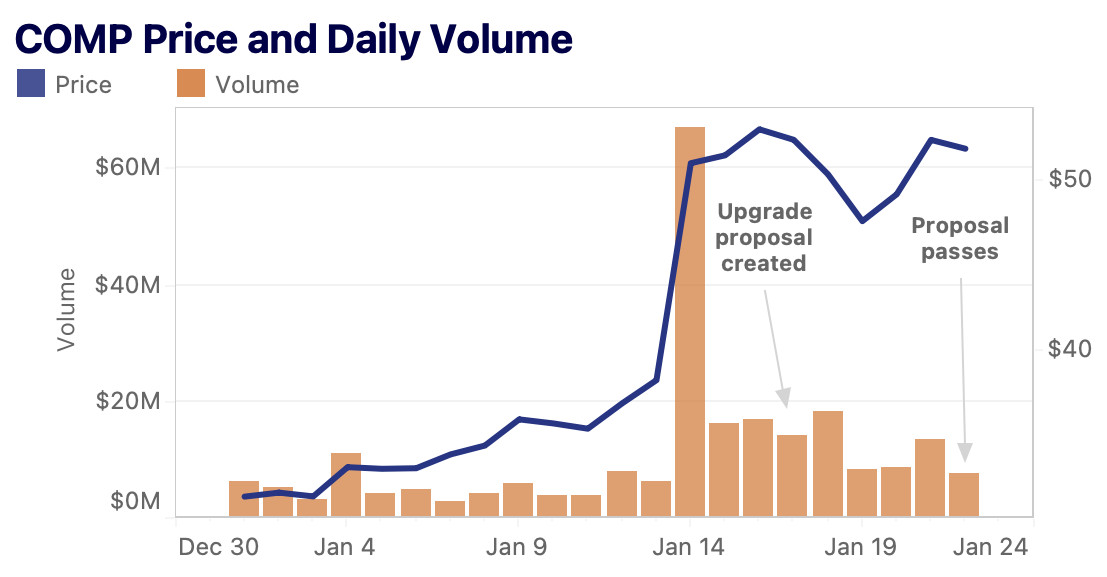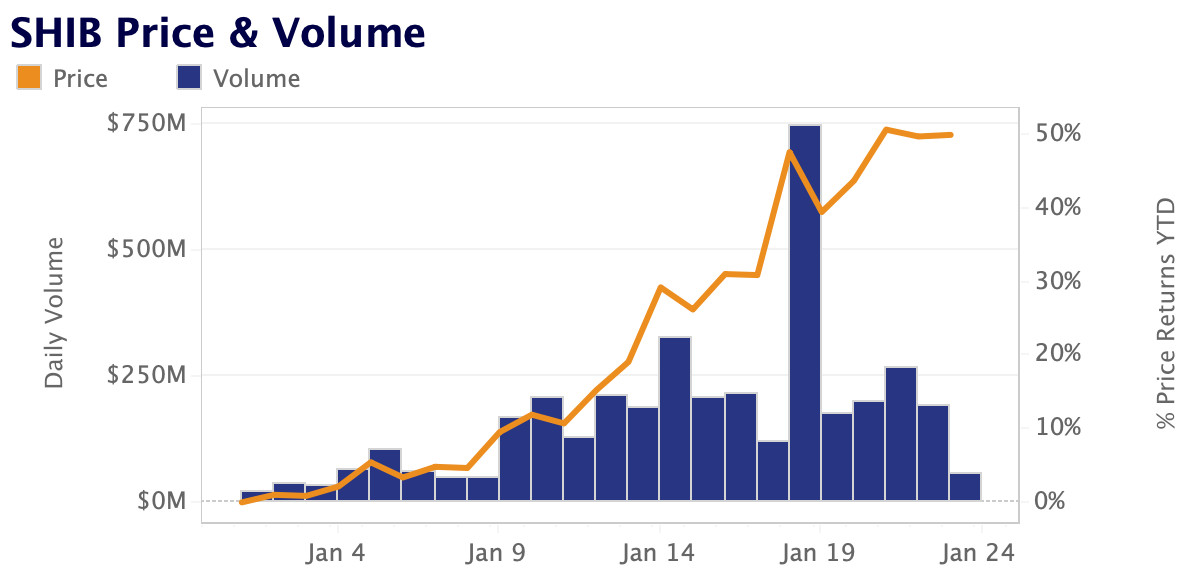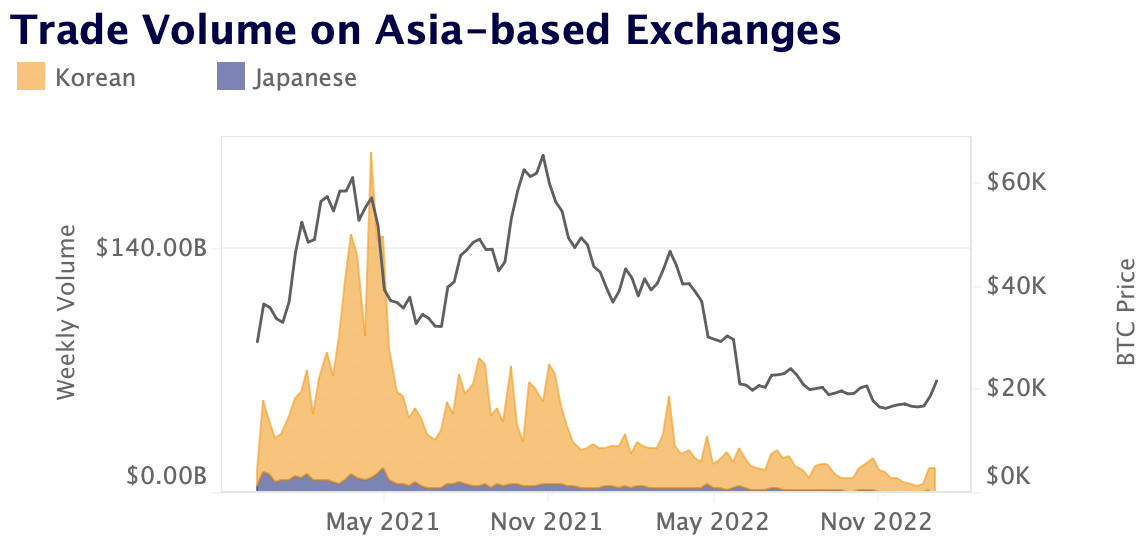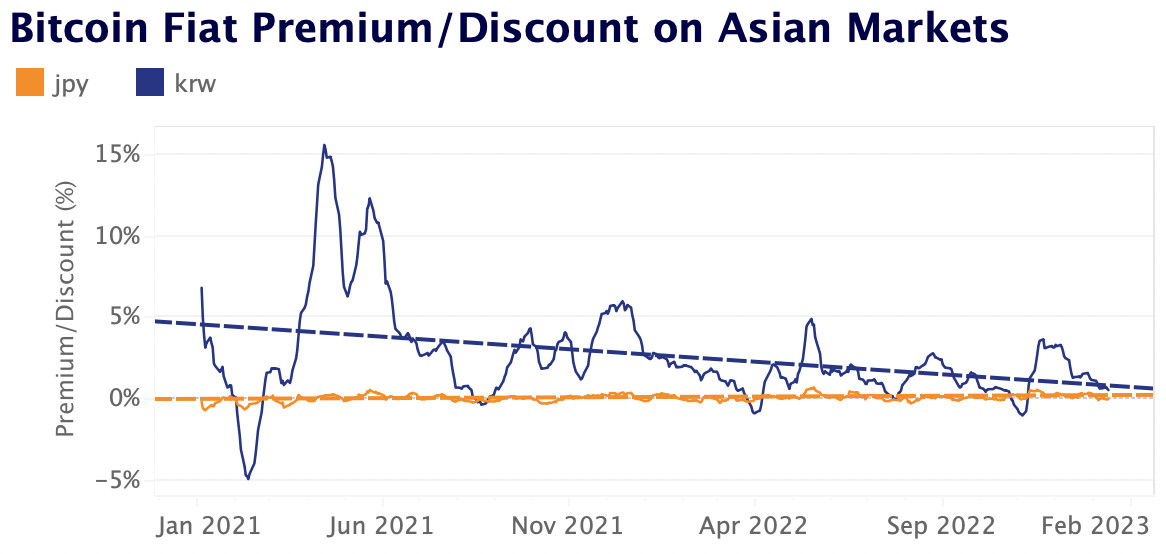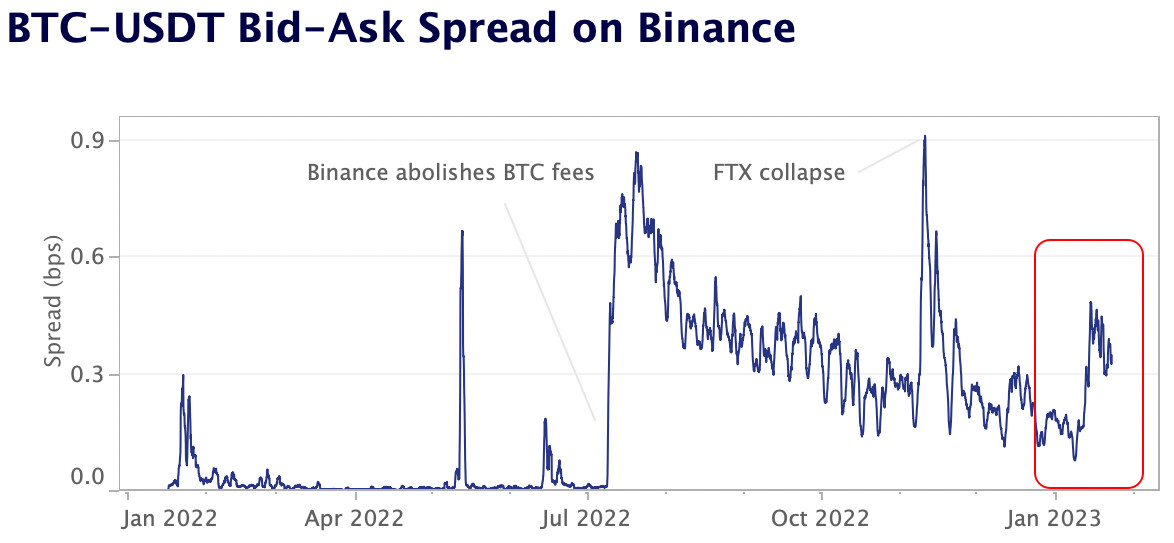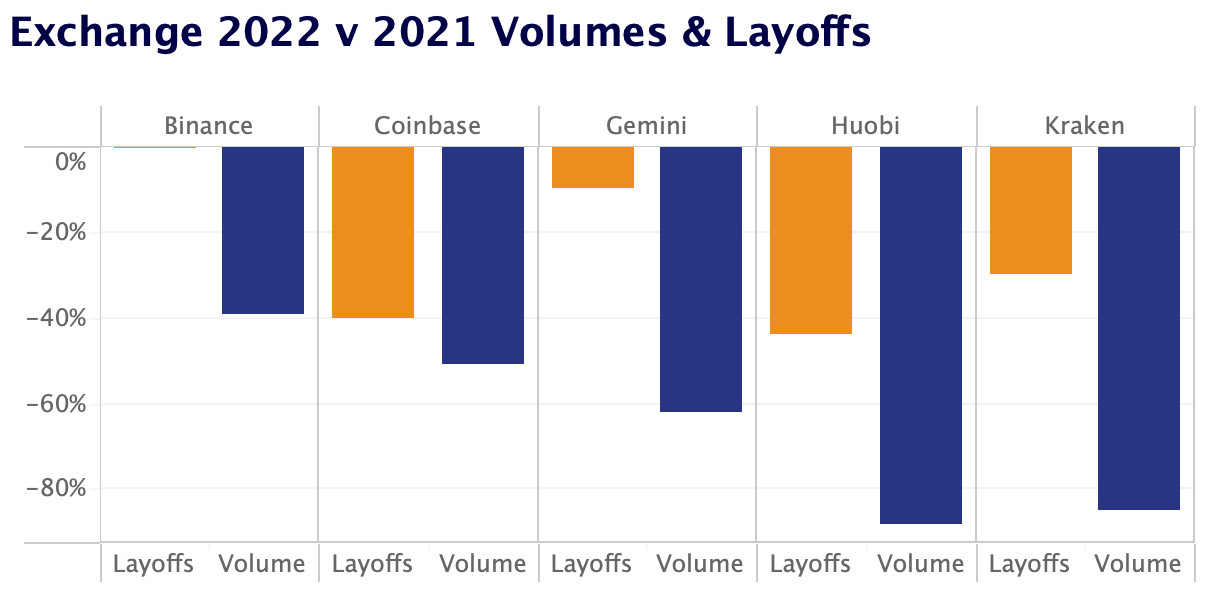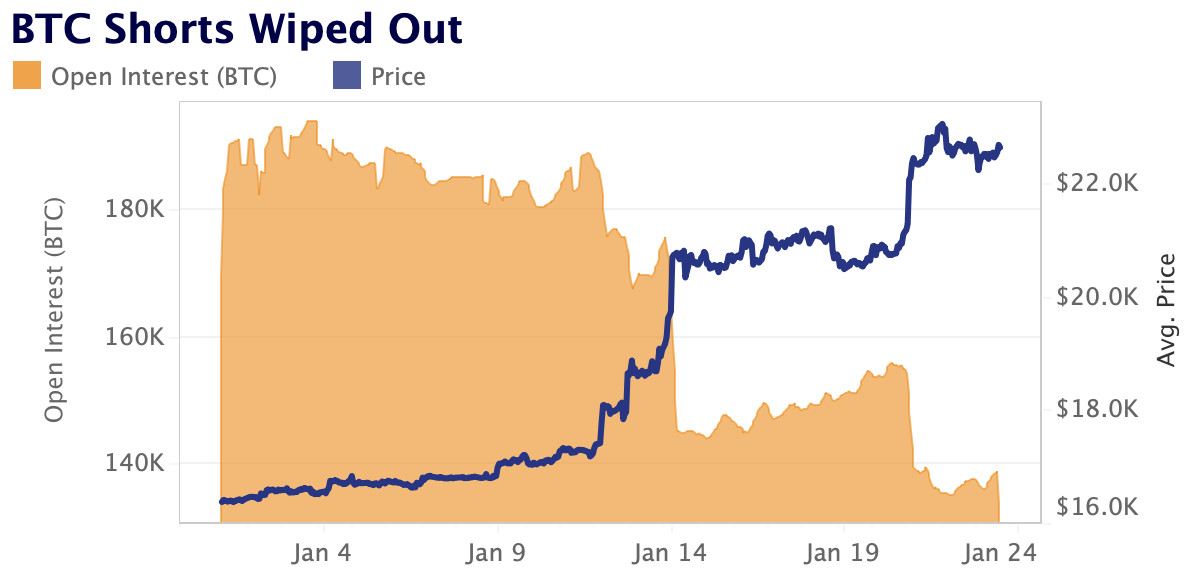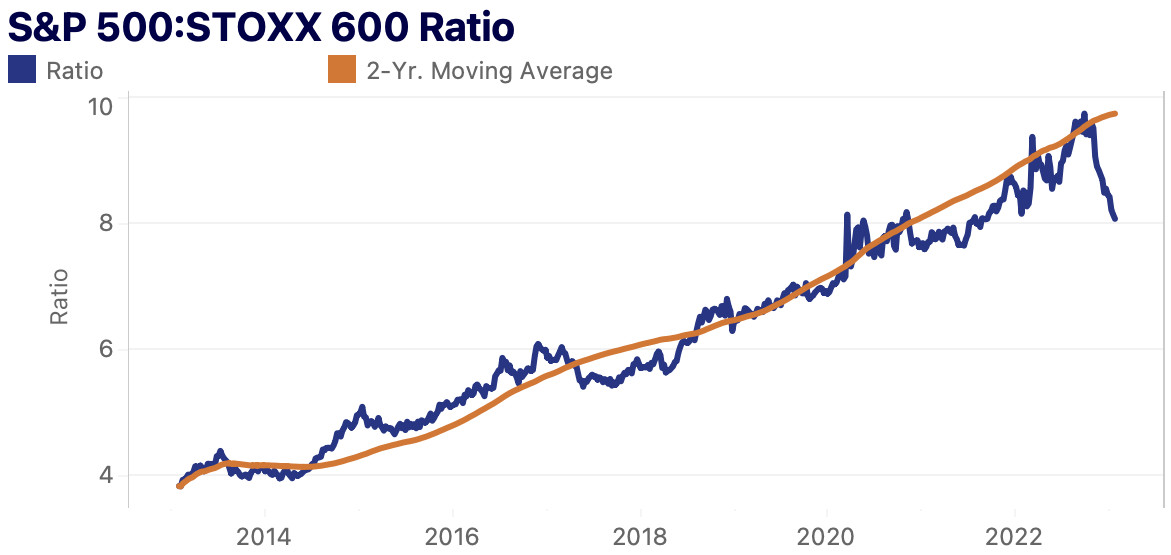A summarizing review of what has been happening at the crypto markets of the past week. A look at trending sectors, liquidity, volatility, spreads and more. The weekly report in cooperation with market data provider Kaiko.
The last 7 days at the cryptocurrency markets:
- Price Movements: BTC gained another 10% this week despite news that Genesis had filed for bankruptcy, with a reported $5bn in liabilities.
- Market Liquidity: Trade volume on the largest Asia-based exchanges fell to multi-year lows amid a tough regulatory environment in the region.
- Derivatives: BTC open interest has dropped 25% as a short squeeze hits derivatives traders.
- Macro Trends: U.S. futures ETFs were more resilient than Canadian spot ETFs during the crypto winter.
BTC gains another 10%
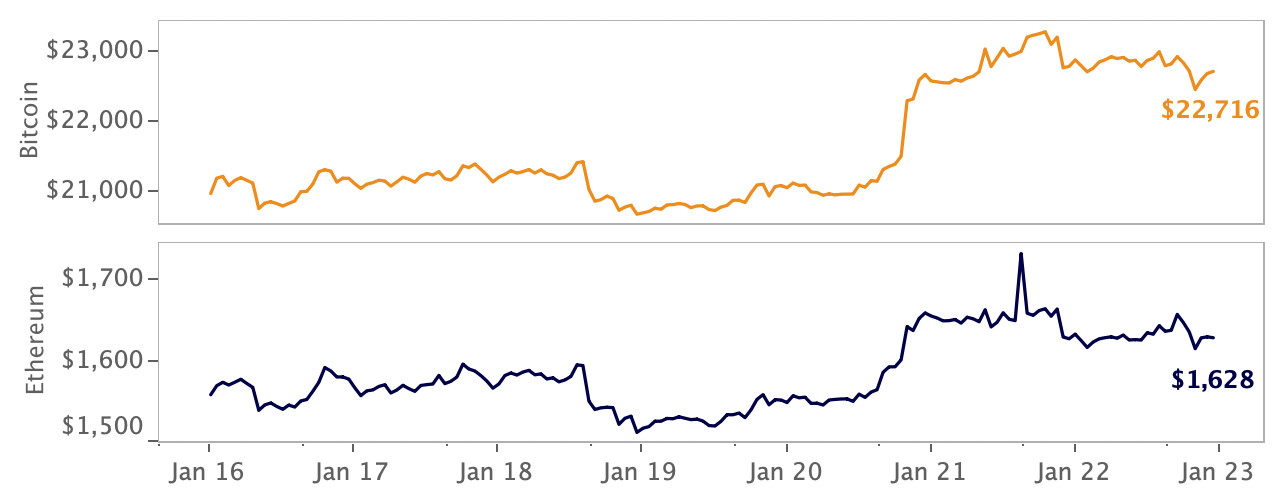
The bulls are (still) here. Bitcoin (BTC) is up more than 10% and Ethereum (ETH) up 6% over the past seven days, despite news that Genesis' lending business filed for bankruptcy, with an estimated 100,000 creditors and more than $3.5bn owed to the likes of Gemini, Cumberland, and VanEck. In the U.S., the Department of Justice announced an enforcement action against Bitzlato, which reportedly laundered more than $700mn. On a lighter note, the number of Ethereum validators crossed 500,000 for the first time, Binance will allow investors to keep collateral in cold storage, and the National Australia Bank announced the creation of a stablecoin.
COMP price increases 50% ahead of V3 vote
COMP, the native token of the lending and borrowing protocol Compound, is up 50% in the last two weeks after the protocol’s governance passed a proposal to deploy its V3 ETH market. The passage of this proposal means that users will be able to deposit a variety of tokens to borrow ETH.
Interestingly, the COMP volume and price surge actually occurred on January 14, three days before the proposal was officially submitted. It appears this was related to increasing discussion in the governance forum around submitting the proposal. It is expected that Aave, Compound’s top competitor, is approaching the rollout of its V3, which will create a cross-chain liquidity pool, which differs from Compound's individual lending market deployments, which can be read more about here in our Compound vs. Aave Deep Dive.
Memecoin no more: SHIB ecosystem expands to Layer 2
SHIB’s price has soared 50% following news that Shiba Inu developers are releasing a Layer 2 blockchain on top of Ethereum, which includes a new SHIB tokenomics plan to reduce supply. Layer 2 blockchains are built on top of Layer 1s and bundle multiple off-chain transactions into a single Layer 1 transaction. This helps reduce congestion on the Layer 1 network, improving transaction speeds and reducing fees.
The new Shiba Layer 2, Shibarium, will reportedly focus on metaverse and gaming applications which could position SHIB to capitalize on a sector with massive growth potential in the coming years. What is interesting is that SHIB started as a meme-based dog token with no fundamentals and a booming price. Since then, it has made efforts to build out its own ecosystem, giving it genuine fundamentals that move it further from meme token status. Investors are clearly happy with Shiba’s commitment to building during a bear market.
Trading volumes on Asian-based exchanges hit multi-year low
Trade volumes on Asia-based exchanges have hit multi-year lows, dropping faster than U.S. markets. Volumes in 2022 on the big four Korean exchanges - Bithumb, Korbit, Coinone and Upbit - fell by over 70% relative to 2021, compared with a 50% drop on Coinbase. The stark divergence is likely due to tighter regulation and negative spillovers from the dramatic collapse of the Terra ecosystem.
Trade volumes on the six major exchanges catering for clients in Japan have also collapsed. Notably, Liquid exchange, which was acquired by FTX in March 2022, has halted all activity. Coinbase and Kraken (not charted) have also halted their businesses in Japan, citing tough market conditions.
A further look at the BTC-fiat premium on Korean and Japanese markets suggests that crypto demand has been cooling since 2020. The so-called Kimchi premium, the gap in BTC prices on Korean exchanges relative to U.S. markets, has been on a steady downward trend, falling from over 15% as of April 2021 to an average of 3% currently. Bitcoin’s premium on Japanese markets remained very low, averaging around 0.1% last year.
Falling inflows from Chinese Bitcoin miners, which research shows were likely the main beneficiaries of the BTC premium trade, could also explain the higher than average drop in trade volumes in South Korea.
Bitcoin spreads on Binance remain historically high
Spreads on the largest crypto market in the world, the BTC-USDT pair on Binance, have deteriorated in January. This could be linked to higher market volatility, the Genesis bankruptcy, or a reduction in activity linked to the Lunar New Year. Spreads are currently at their highest levels since November.
Overall, BTC-USDT spreads on Binance have widened significantly ever since the exchange permanently eliminated fees for 13 BTC trading pairs in July 2022. While boosting trade volumes, this has also led to higher costs for market makers. The zero-fee pairs were excluded from the Binance spot liquidity provider program, which offers fee rebates of up to -0.01%. Binance currently has higher BTC-USDT spreads than other major USDT markets such as Huobi and OKX.
It is notable that we do not observe the same trend on Binance.US which also eliminated Bitcoin fees in July. This suggests that the impact of fee removals on liquidity is not linear and depends on exchange microstructure (the fee structure and level of competition between liquidity providers).
An analysis of crypto exchange layoffs vs. trade volumes
The crypto winter continues to impact the bottom line of crypto exchanges, and in line with moves in the tech industry, crypto jobs have been cut en masse in an effort to trim down excessive spending. According to Coindesk, over 29,000 crypto jobs have been lost as of January 17 this year. With crypto trade volumes down across the board, exchanges in particular have looked to rectify over-hiring that took place in the bull run of 2021.
Exchange volumes have fallen between 40-90% in 2022, compared to 2021, placing greater stress on exchanges, which derive the majority of revenues from transaction fees. Coinbase has laid off about 40% of staff in the last year and recorded a drop in volume of 50%. The exchange faces greater scrutiny because it is publicly listed and must answer to shareholders. Interestingly, Binance has not announced any large scale layoffs despite volumes dropping nearly 40% year-on-year, while Gemini has only laid off 10% of staff so far, despite a drop in volumes of over 60% since 2021.
BTC shorts caught off-guard
BTC open interest has fallen over 26% in BTC terms to start 2023 as it appears BTC short positions in derivative markets have been caught off guard. While the price of BTC has surged 38% YTD, 50k BTC worth of positions have been closed, indicating short positions in the derivatives market have been liquidated at higher prices. While lower levels of open interest usually indicate less interest in markets, the removal of leveraged positions could be exactly what crypto markets need at present, with price discovery returning to spot markets.
European stocks continue outperformance of U.S. stocks
The STOXX 600 index – an index covering 600 European stocks – again gained ground last week against the S&P 500, continuing to break a 10+ year underperformance streak.
The 2-year moving average was broken in the final week of October, and since then the ratio has declined from 9.5 to 8 despite a rally in U.S. markets. STOXX 600 has surged nearly 20% off its low in September, bolstered by a weakening dollar and slowing inflation. However, analysts polled by Bloomberg expect that the index will finish the year at 452 points, a 1% drop from its close on Friday.
Bitcoin’s price movements are more tightly correlated to U.S. equities compared with European markets. Its 30-day rolling correlation with European equities is relatively low at around 0.3 as while its correlation to the S&P 500 hovers around 0.5.


